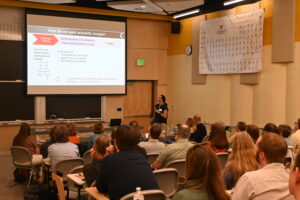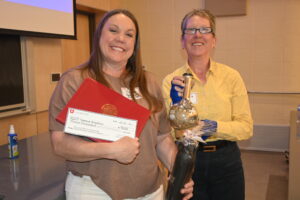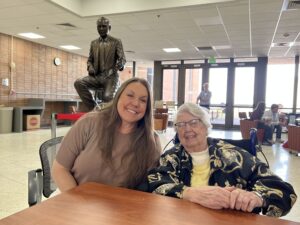2025 High School Chemistry Teachers' Workshop
On Saturday April 26, we held our semi-annual high-school chemistry teachers’ workshop in the Department of Chemistry at the University of Utah. Organized by Michael Morse, Gina Frey, and Jil Brandol, the Saturday morning event brought together more than 40 participants comprising high-school chemistry teachers from around the region. The workshop promotes learning about and discussing ideas about the teaching of chemistry. This event is becoming quite a reunion with numerous returning teachers joining us, as well as Eileen Ragsdale, her son Steve, his wife Naomi, and her daughter Krista attending. We were equally thrilled to welcome many new teachers to the event!

Participation in the workshop counts towards continuing teacher education credit and is designed to assist Utah chemistry teachers in deepening their understanding of specific chemistry topics that interest them, as well as discussing current research in chemistry education about teaching and learning. With a line-up of Chemistry Department faculty, the program consisted of three presentations. Michael Morse gave a wonderful start to the morning with an engaging talk about lasers and the physical principles behind their operation. In essence, a laser functions by exciting atoms in a medium, causing them to release photons via stimulated emission. This light can be amplified only when a population inversion – more atoms in an excited state than in a lower state - is achieved, aided by highly reflective mirrors. Light bouncing back and forth between the mirrors stimulates the emission of additional photons that are identical in energy, polarization, direction of propagation, and wavelength to the photons that stimulated the emission. One of the mirrors is slightly transmissive, so the laser output is emitted through this window, with greatly reduced intensity compared to the intensity that is circulating inside the laser cavity. A population inversion cannot be achieved by simply heating the medium; as Michael vividly described, it requires “hitting the molecules with a (metaphorical) hammer!” Then we explored the processes of the common Helium-Neon laser, originally used in supermarket scanners, and excimer lasers, which are used in LASIK eye surgery and photolithography for fabricating microchips. We greatly enjoyed and learned much from Michael’s talk, which provided an excellent foundation as we look forward to exploring CO2 lasers and semi-conductor lasers in the fall.
After the morning break, Aurora Clark gave an insightful talk on artificial intelligence (AI) and machine learning in chemistry, focusing on “how it learns, how it teaches.” She explained that AI is the broad field containing various approaches aimed at creating machines capable of thinking and learning in ways similar to humans. Within AI, machine learning focused on using algorithms that learn from data without being explicitly programmed. A more specialized subset, deep learning, employs multi-layered artificial neural networks to recognize complex patterns in large data sets. Aurora emphasized that, as scientists, we can use AI to help gain scientific insight and predict scientific phenomena, while as educators, we can use it to better understand our students’ learning and provide more effective support. She described the process of creating an AI model: starting with observed data, identifying relationships between variables, and then using insight to improve the model and define the model’s limitations.
In AI modeling, the data are typically divided into three sets (training, testing, and validation), and the development process is iterative. It involves collecting and preparing data, splitting the data, training the model, testing and validating the model, and applying the model. Importantly, Aurora stressed that human judgement is essential at every step of the process, with machines and software doing the computational work. She also gave a vital reminder: AI models, such as ChatGPT, are only as reliable as the data they are trained on. If the data are incomplete or biased, the model’s outputs will reflect those flaws. Aurora’s talk was both fascinating and thought-provoking—we all left wanting to hear more.
In the final session, Gina Frey discussed practical strategies for structuring effective in-class group work. She began with an informal small-group discussion about the participants’ experiences using group work, then noted that while collaborative-learning classrooms may look chaotic, there is structure underlying that chaos. Gina outlined four key components of successful collaborative learning: (1) thoughtful planning at both the course and class-session levels, (2) designing engaging and purposeful activities, (3) giving clear and detailed instructions before and during the activity, and (4) facilitating structured reporting out to the entire class. In the planning phase, instructors should identify learning objectives for group work, adapt the curriculum accordingly, and form groups deliberately. Activity design should focus on promoting discussion, with tasks that can be completed in 8–10 minutes or incorporate a whole-class check-in every 10 minutes. Effective implementation begins with explaining to students why group work is being used, how it will be structured, setting clear expectations, and establishing ground rules. Before starting an activity, instructors should provide specific instructions and a defined time limit, and assign roles within groups to ensure all students are engaged. During the activity, instructors should circulate, observe, and actively listen without disrupting group dynamics. Facilitating a structured discussion is essential when regrouping the class. Ask groups to contribute a single idea or key point while sharing their reasoning, and then synthesize those contributions into clear takeaways for the whole class. Many valuable insights and thoughtful questions were shared by participants, and Gina noted that the POGIL Project offers a wealth of resources to support collaborative learning on their website.
The annual Ron and Eileen Ragsdale High School Teaching Award was also presented to Tamra Rossiter from Riverton High School during this event. This award honors a regional high-school chemistry teacher for their outstanding teaching characterized by engagement, dedication, equitability, evidence-based teaching practices, and high standards for their students. It also recognizes a commitment to collaboration with fellow educators throughout the Valley and participation in the Department’s outreach programs. The recipient receives a monetary award, a certificate, and a “silver flask” made by our own Jeff Statler. We were delighted to give this award to Tamra, whose innovative teaching, continuous professional growth, and efforts toward fostering a group mindset for chemistry in her students. Her colleagues described her as a dedicated educator and mentor – a leader who constantly searches for new ways to teach challenging concepts enhancing student learning, and encourages students to reach their full potential. Tamra is a long-standing participant in this high-school teacher event, and has special connection to Ron Ragsdale, having worked with him early in her career to develop chemistry labs that could be conducted at home (a bit of “kitchen chemistry”). She spoke warmly of Ron’s lasting impact on her own teaching and on chemistry education throughout the Valley.


Tamra Rossiter and Gina Frey Tamra Rossiter and Eileen Ragsdale
Meaningful conversations took place throughout the workshop, including during the break and lunch, fostering a local community of teaching and learning. We will be holding the next workshop this fall (2025). We look forward to seeing all the high-school and middle-school teachers, the undergraduate chemistry majors, and the Ragsdale family again, and we invite interested chemistry graduate students and faculty in the department to join us also.
5/2/2025
